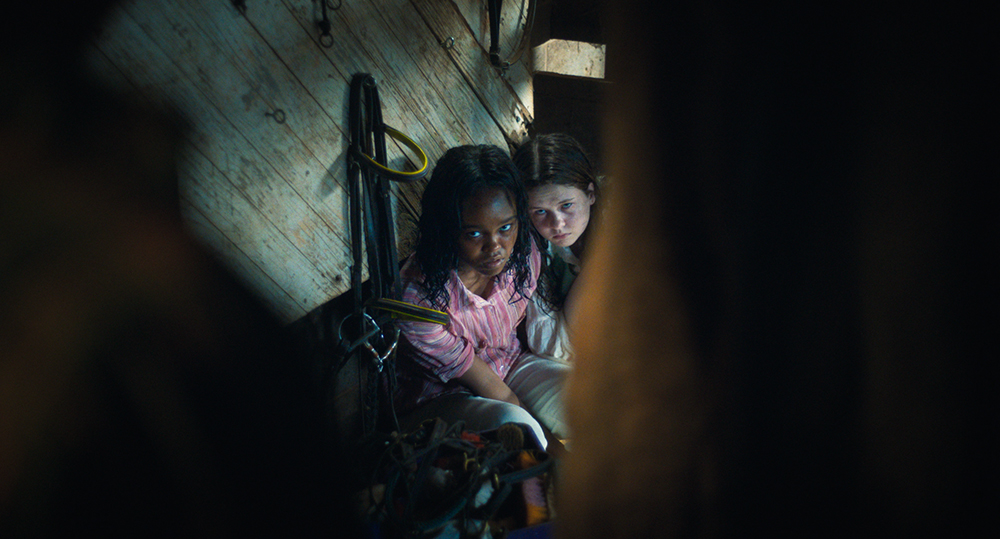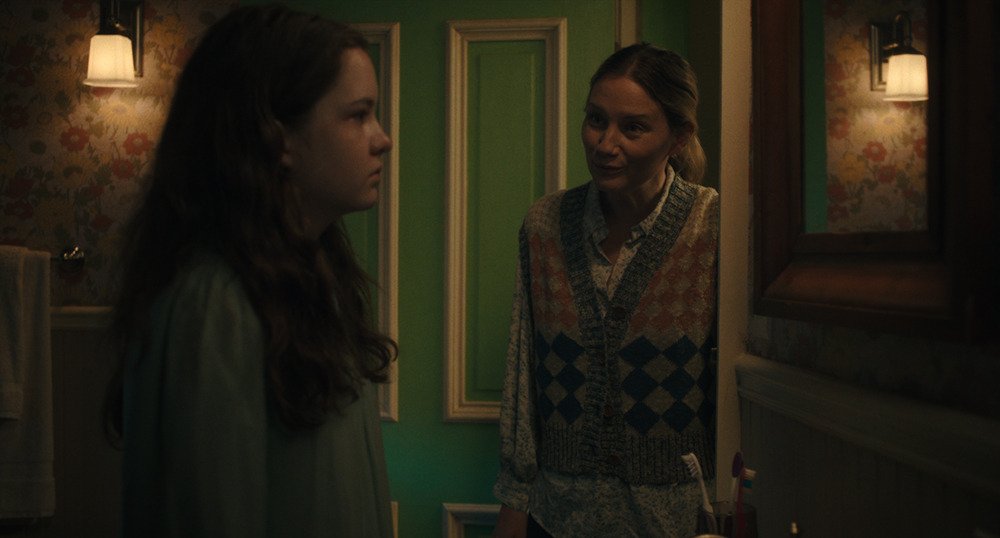THE EXORCIST: BELIEVER Isn’t Bad, but Isn’t New, Either

 The Exorcist: Believer (2023)
The Exorcist: Believer (2023)
Screenplay by Peter Sattler and David Gordon Green
Based on characters created by William Peter Blatty
Produced by Jason Blum, David C. Robinson, and James G. Robinson
Directed by David Gordon Greene
Rated R, 1hr 51m
There was always going to be a lot to try and live up to from David Gordon Green’s The Exorcist: Believer, and not just in trying to measure up to the celebrated original. Since William Peter Blatty’s novel was adapted for the screen by William Friedkin fifty years ago — and basically set the bar that all films about demonic possession are measured by — the popularity of the horror genre has waxed and waned and waxed again; two film sequels, two versions of a prequel, and a TV series have hit screens large and small; and legions — haha, a pun — of imitators and parodies have made their way in front of audiences.
But like so many franchises, what followed the original that created the interest in continuing the story have not managed to capture the magic or influential nature of that first film, despite the talent or desire involved. The first sequel Exorcist II: The Heretic, is widely regarded as a cinematic disaster, and even William Peter Blatty directing and adapting his sequel novel Legion for Exorcist III couldn’t capture that impact the original had on audiences. The saga of the two prequel versions is a topic unto itself, and even good reviews couldn’t keep the Fox TV series on the air for more than two seasons.

So when I tell you that 2023’s The Exorcist: Believer doesn’t measure up to 1973’s The Exorcist, it may not come as huge surprise, especially if you’ve been following along with David Gordon Green’s revival of the Halloween franchise. For all the praise Green received for 2018’s Halloween, the subsequent sequels seemed to please audiences less and less, and that doesn’t bode well for the planned sequels for Believer. Of course it’s too early to tell how audiences will react to this new story; it certainly could become a box office success considering its relatively lean $30 million budget — and, currently, there is a sequel slated to be released in April of 2025.
But the bar is high, so what does “doesn’t measure up” mean?
Set in Georgia, Believer tells the story of photographer and single father Victor (Leslie Odom Jr., Hamilton, Glass Onion) and his 13-year old daughter Angela (Lidya Jewett, Black Panther); Miranda (Jennifer Nettles, Harriet) and Tony (Norbert Leo Butz, Debris, Fosse/Verdon), parents to Angela’s friend Katherine (Olivia Marcum, 30 Coins); and Victor’s nurse neighbor Ann (Ann Dowd, The Handmaid’s Tale). If you’ve seen the trailers, then you know the premise: Angela and Katherine wander off into the woods, disappear, and are found three days later miles from those woods with no memory of the days they were missing. And, much to their parents’ horror, they didn’t come back alone.

This first part of the film — before we get into clear signs of possession and returning characters from the original film — is the most effective. Focused primarily on Odom’s Victor and Jewett’s Angela, we see a father who is a little too protective of his daughter, a mindset that is largely shaped by the tragic death of her mother when she was born. Theirs is a loving and mostly healthy relationship, although Angela would like to have her dad be a little less protective, and she is keenly aware of the mother-shaped hole in her life. We see them get ready for their day — her to school, him to his photography studio — as they banter and tease and play with each other. This connection and happiness they have together is meant to show us what things are like in this little family, so the contrast of what is to come and Victor’s horror at its effects on his daughter is heightened. And it mostly works, let down only by not really spending enough time with these characters before things go bad, and that will become a recurring problem for the rest of the film.
Unfortunately, Katherine, her parents, and her siblings don’t even really get that much development. We know that she and Angela are friends — they have a couple brief scenes together at school, then a too short but effective scene as they make their way into the woods — and that her family are faithful members of a Baptist church, but aside from that there isn’t much else until Miranda and Tony meet Victor as he’s trying to find out where his daughter is. Victor’s neighbor Ann, initially presented as a bit of a neighborhood busybody, gets enough backstory to lead Victor to Ellen Burstyn’s returning Chris MacNeil, and then things get worse for anyone else who gets more than a few lines. Victor’s friend Stuart (Danny McCarthy, Prison Break) is apparently a preacher himself (although that slipped past me entirely in the theater) and is there to be supportive and introduce Victor to Dr. Beehibe (Okwui Okpokwasili), who practices ritualistic medicine. The pastor of Miranda and Tony’s church (Raphael Sbarge, Once Upon a Time) joins in once the parents of both girls realize they are dealing with demonic forces, and because it is an Exorcist film, we have Catholic priest Father Maddox (E. J. Bonilla, Bull).

All of these actors are very talented people, who do the best they can with what they have here, but I honestly had to look up the names of their characters on IMDB, since they aren’t given much more to do than to be supportive or provide help with the exorcism. This mostly works in the first part of the film, where we’re focused on Victor, and even to an extent when the girls start behaving in more and more disturbing ways. But in a film where the possession isn’t limited to one little girl, it’s disappointing that we don’t get more of Katherine’s family and life before it all goes bad, because in the end, both girls are possessed, and both girls’ souls are on the line.
The film continues to be a pretty effective horror film once the girls are found and the signs of possession become clear. Both Jewett and Marcum lean into first the appearance of traumatized teens and then the histrionics of demon possession, and they both give suitably sad, creepy, and deeply disturbing performances. Here we see the girls go through the distressingly clinical medical examinations and police interviews that would follow kids disappearing for three days, and here we see the parents dealing with the nightmare of getting their missing children back, and then losing them to seeming madness and insanity. Katherine’s parents turn to their faith to help them deal with it, but Victor lost his a long time ago, and one of the most chilling scenes in the film is his tour of a mental health facility. Not because it is such a terrible place, but because you can see on his face the horror of the thought of putting his daughter there because he can’t help her.
And then Victor’s neighbor Ann tells him about a lady who might be able to help.

Things kick into the exorcism-picture high-gear, and while there is something to be said for the film’s multi-denominational take on dealing with possession — family, community, and faith having real power — it’s also kind of what you expect it to be. That’s not entirely a criticism, by the way. I think they did a really good job with the exorcism scene, but we run into the problem that this is an Exorcist movie. The original set the mold, and most films dealing with the subject were heavily influenced by that, so there’s a certain predictability to the proceedings. It’s not a bad thing, but if you’re a horror fan who has seen more than a few of these kinds of films, you might not find a lot to surprise you here. There is a terrible choice the demons want our heroes to make that was a nice, disturbing touch to up the ante and adds a chaotic wrinkle, but other than bringing several faiths together to fight the demons, there’s really not much we haven’t seen before.
And that, I’m afraid, is one of the overall issues I have with The Exorcist: Believer. There just isn’t that much that is new here. Now, to be fair, I watch a lot of horror films, so I’ve seen a lot of films about demonic possession. Audiences who aren’t as familiar with this part of the horror genre as I am might find these scenes scarier or more shocking, which is great! But even on its own, and just comparing it to the original film, Believer treads the same ground more than it diverges, and even those differences can cause problems.

The first film revolved around a single mother, her possessed daughter, and the two priests who try to help. The smaller number of main characters meant we got to spend more time with Chris and Regan MacNeil, raising the stakes because we knew the characters better. We had time for discussions about the natures of good and evil between Father Merrin and Father Karras, defining the spiritual battlefield where the priests would face the demon.
Here, with so many characters, nobody gets enough time. And that’s a shame because these are award-winning actors who are giving really good performances, but who aren’t given enough time to give their characters enough depth. Even Leslie Odom Jr, the main character, is given short shrift by, for example, bringing up his antipathy to religion and anger towards someone trying to comfort him through their faith, and then not explaining or dealing with it before he abandons it for the finale. There’s a powerful scene missing there that I wanted to see Odom deliver, that the film just doesn’t set aside the time for. It’s crowded with great actors and stuffed with ideas, but doesn’t let any of it breathe enough.

And that, I’m sad to say, is where we get to Ellen Burstyn’s return as Chris MacNeil, the mother of the possessed Regan from the original The Exorcist. Burstyn is great, she’s always great… and she’s completely unnecessary to the story. Sure, it’s cool to have her back, it connects this sequel to the original, and she gets to be the Wise Old Sage for our troubled Victor, but she’s in the film for just a few moments, really, before we have a scene that both makes no sense for the story or for her character, and then she’s mostly gone from the film. As nice as it is to have her back, you could cut all of her scenes and it honestly wouldn’t have any impact on the rest of the film.
Now here’s the qualifier: I saw this film with an audience at an advanced screening, and based on the gasps and shrieks and groans at the appropriate places, a good percentage of the audience was reacting how you would imagine the filmmakers intended. A scene at the end — which I shan’t spoil here — even got a little applause. There’s a lot of detail I didn’t go into here, and ideas and scenes in the film I did think were interesting and effective. I watch a lot of horror, and my “not much new here” might be something that you’ve never seen before, and you might find the characters developed more than enough. And it is clear that the filmmakers were trying to evoke the memory of the first film, from imagery, music, and dialogue that mirrors or echoes The Exorcist. At least some of that “not much new” is intentional, and how that effort affects you may be the deciding factor in whether or not you like this film.
Because this isn’t a bad film, or even really a bad Exorcist film. I’ve seen a lot of bad horror, and seen lots of bad horror films become hits. It’s certainly better than Exorcist II: The Heretic — I know, damning with faint praise — and better, I think, than either version of the prequel film. I’d put it right behind The Exorcist III, in large part because the third film tried to do something different than the first, tried to tell a different kind of exorcism story, and it largely succeeded. This film doesn’t really try to be different from its inspiration, and in the end, that’s my biggest criticism of The Exorcist: Believer.
![]()




